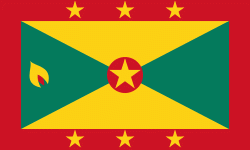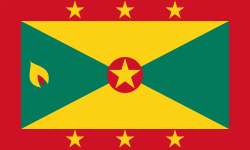Carriacou and Petite Martinique (Carriacou and Petite Martinique)
 |
Carriacou Island is the largest island of the Grenadines, an archipelago in the Windward Islands chain. The island is 13 sqmi with a population of 9,595 (2019 census). The main settlements on the island are Hillsborough, L'Esterre, Harvey Vale, and Windward.
The neighbouring island of Petite Martinique is 2.5 mi away from Carriacou, and also a part of Grenada. With its 586 acre and population of 900, it is smaller than Carriacou. The residents of this island live by boat-building, fishing and seafaring. Carriacou and Petite Martinique are known for its Regatta and Village Maroon.
On 27 September 1650, Jacques du Parquet bought Grenada from the Compagnie des Iles de l'Amerique, which was dissolved, for the equivalent of £1160. In 1657, Jacques du Parquet sold Grenada to Jean de Faudoas, Comte de Sérillac, for the equivalent of £1890. In 1664, King Louis XIV bought out the independent island owners and established the French West India Company. In 1674, the French West India Company was dissolved. Proprietary rule ended in Grenada, which became a French crown colony as a dependency of Martinique.
Carriacou and Petite Martinique was part of the French colony in 1762. It was part of the British Grenada colony from 1763 to 1779 and 1783–1974. It was part of the French Grenada colony from 1779 to 1783. During this turbulent period, most of the land on Carriacou and all of the property on Petite Martinique was owned by a free black woman, Judith Philip, and her family members. It has been a dependency of Grenada since 1974.
Map - Carriacou and Petite Martinique (Carriacou and Petite Martinique)
Map
Country - Grenada
 |
 |
| Flag of Grenada | |
Before the arrival of Europeans in the Americas, Grenada was inhabited by the indigenous peoples from South America. Christopher Columbus sighted Grenada in 1498 during his third voyage to the Americas. Following several unsuccessful attempts by Europeans to colonise the island due to resistance from resident Island Caribs, French settlement and colonisation began in 1649 and continued for the next century. On 10 February 1763, Grenada was ceded to the British under the Treaty of Paris. British rule continued until 1974 (except for a brief French takeover between 1779 and 1783). However, on 3 March 1967, it was granted full autonomy over its internal affairs as an Associated State, and from 1958 to 1962 Grenada was part of the Federation of the West Indies, a short-lived federation of British West Indian colonies.
Currency / Language
| ISO | Currency | Symbol | Significant figures |
|---|---|---|---|
| XCD | East Caribbean dollar | $ | 2 |
| ISO | Language |
|---|---|
| EN | English language |















